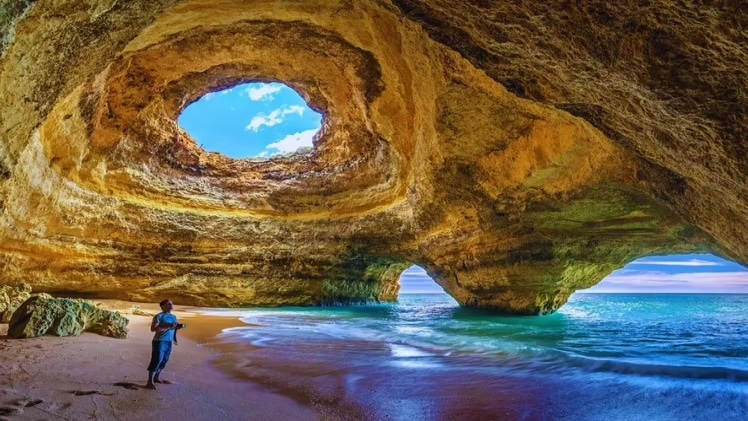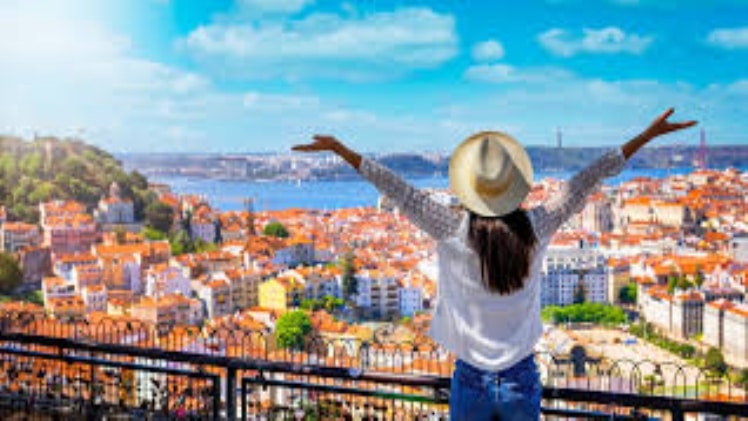Portugal might be compact in size, but it packs in an incredible mix of history, landscapes, food, and charm. Planning a 12-day trip across the country can feel overwhelming—there’s just so much to see—but with a little smart routing and a few insider tips, you can experience the highlights without rushing or backtracking.
This guide is built on a tried-and-tested itinerary: flying into Porto in the north, traveling through the Douro Valley, Lisbon, and Sintra, and ending on the sunny Algarve coast before flying out of Faro. It’s the perfect balance of culture, relaxation, and stunning nature. Let’s break it down.
Porto (Days 1–4)
The journey begins in Porto, one of Europe’s most atmospheric cities. Think river views, tiled facades, and port wine cellars.
If you’re new to Portuguese food, a walking food tour on day one is the perfect intro. Not only will you taste the city’s staples like francesinha and pastéis de nata, but you’ll also get context for local dining culture and ingredients. And if you’re looking to escape the urban buzz for something a little more nature-focused, bolhas da montanha offers a unique and tranquil retreat in the heart of Portugal’s countryside.
Don’t miss the Mercado do Bolhão. It’s chaotic, colorful, and completely authentic. The Ribeira District is made for aimless wandering, especially around Largo da Pena Ventosa—arguably one of the prettiest corners in town.
A port tasting across the river in Vila Nova de Gaia is practically a rite of passage. Caves Calem is popular, while Cockburn’s offers a more refined experience. In the evening, catch a Fado performance at Taberna Real do Fado. It’s a full dinner-and-show affair that leaves a lasting impression.
One unexpected highlight? A VW bus tour of the city. It’s an open-air ride that takes you to tucked-away cathedrals, beaches, and viewpoints even savvy travelers might miss.
Base yourself at Vitoria’s Terrace Apartments. The location is quiet yet central, the views are phenomenal, and the hosts go above and beyond with recommendations.
Day 5: Historic Villages Between Porto and Lisbon
Instead of hopping a train directly to Lisbon, consider hiring a driver and turning the travel day into an adventure. Aveiro, known as the “Venice of Portugal,” is cute but skippable if pressed for time.
Nazaré, famous for record-breaking waves up to 30 meters high, is more than just a surfing town. The cliffside views and pink marble cathedral make it worth a stop.
But the real gem is Óbidos. This medieval village with whitewashed houses, cherry liquor in chocolate cups, and walkable castle walls is a must-see. It’s charming, easy to explore, and filled with great little shops and cafes. If anything, more time here would’ve been ideal.
Lisbon (Days 6–7)
Portugal’s capital is a heady mix of old and new. Narrow, hilly streets lead to grand viewpoints and tiled buildings with stories to tell. A guided tuk-tuk tour is a great way to cover ground while learning the city’s layered history.
Alfama is where Lisbon began, a tangle of alleyways and local life. Chiado and Bairro Alto offer a different vibe, with shopping, nightlife, and cafes spilling out onto sidewalks. Over in Belém, sample the original pastéis de nata and visit the iconic monastery and tower.
For a drink with a view, try Carmo rooftop bar. Green Street nearby has cozy restaurants and local wine bars that open in the evening. Bohemia LX is a top pick for another Fado night—less touristy than many in the city.
Some spots don’t live up to the hype: Time Out Market felt like a loud food court, and Pink Street, while Instagram-famous, lacked soul. Santa Justa Lift is fun to look at, but not worth standing in line for.
Stay at Ando Living – Abrantes 10 House. It’s clean, stylish, and comes with everything you need, from a washing machine to a full kitchen. The location is ideal—quiet yet central.
Day 8: Sintra Day Trip
Just outside Lisbon, Sintra is straight from a storybook. Extravagant palaces peek through the trees, gardens twist and turn around secret staircases, and the whole town feels slightly magical.
With just one day, choose wisely. Pena Palace and Quinta da Regaleira are the top picks. The former is a colorful masterpiece on a hilltop; the latter feels like stepping into a dream, complete with spiral wells and mystical tunnels.
A private guide makes all the difference here. They manage the crowds, share fascinating stories, and help you cover more ground efficiently. Bonus: you’ll visit places like Azenhas do Mar, a cliffside village known as Portugal’s “Santorini.”

The Algarve (Days 9–12)
After a short flight to Faro and a car rental, the final stretch of the trip unfolds along the Algarve coast. Base yourself in Carvoeiro—midway between the eastern and western Algarve—which offers both serenity and access to everything.
Start with Algar Seco and the Carvoeiro Boardwalk for some of the most stunning sea views and caves you’ll ever see. Then tackle the Seven Hanging Valleys Trail, an 8-kilometer hike that hugs the cliffs and reveals secret beaches along the way.
Don’t skip a kayaking tour of Benagil Cave. It’s the best way to explore the sea caves up close. For more iconic scenery, head to Ponta da Piedade, where towering rock formations make for dramatic photo ops.
Wind down on the beaches—Praia dos Estudantes and Praia da Dona Ana were trip favorites—and take time to explore Ferragudo, a sleepy town perfect for souvenirs and slow wandering.
Quinta do Ourives is the ideal stay here. A six-suite bed-and-breakfast run by a warm, helpful family, it boasts a heated pool, delicious breakfasts, and peaceful surroundings.
Final Thoughts
Twelve days in Portugal fly by. This itinerary is packed but manageable, thanks to smart routing and a good mix of city life, countryside, and coast.
Plan your flights wisely—into Porto, out of Faro—to save time. Book food tours early to get a real taste of the culture. And don’t underestimate the power of a great guide in places like Sintra or the Douro Valley.
Portugal is endlessly walkable, surprisingly affordable, and always rewarding. Bring good shoes, a big appetite, and a sense of adventure—you’ll need all three.


